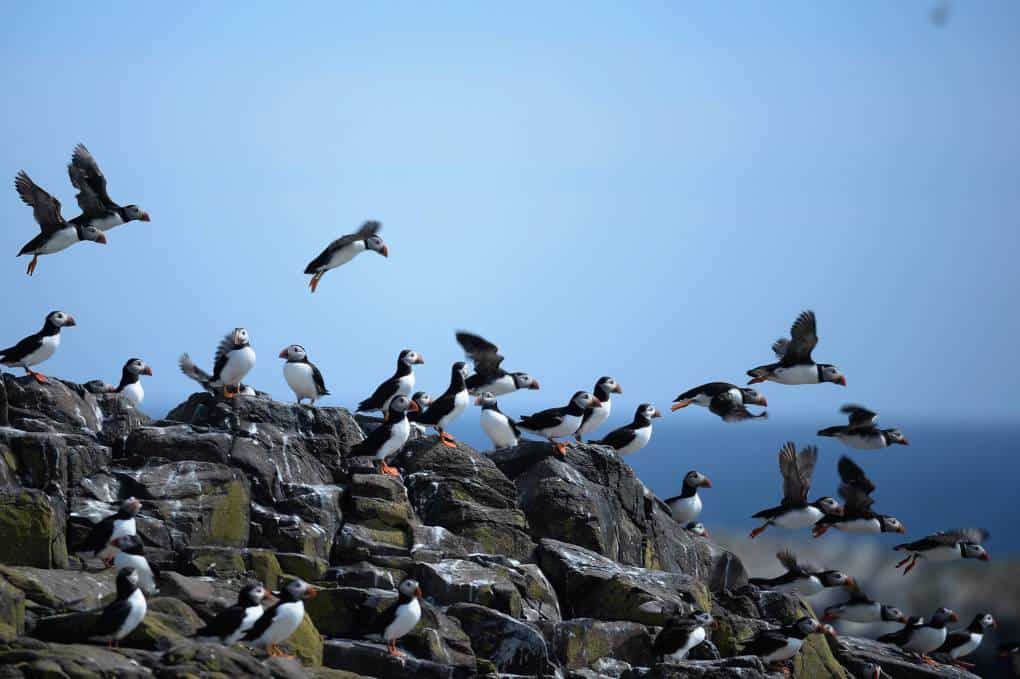

Photo: Puffins return to their summer breeding grounds on the Farne Islands on May 16, 2013, in Farne, England. (Jeff J Mitchell/Getty Images)
Seabirds evolved about 60 million years ago, as Earth’s continents drifted toward their current positions and modern oceans took shape. They spread across thousands of undisturbed islands in the widening seas. And as flying dinosaurs and giant omnivorous sea reptiles died out, seabirds also started filling an ecological niche as ecosystem engineers.
They distribute nutrients, in the form of guano, that’s beneficial to plankton, seagrass and coral reefs, which, in turn, nurtures fish populations that are eaten by seabirds and marine mammals in a cycle that forms a biological carbon pump. The stronger the pump, the more carbon dioxide it pushes into seabed sediment storage.
Seabird colonies of almost unimaginable size likely persisted through eons of profound climate shifts and the geological upheavals of colliding continents, playing a profound role in the ocean carbon cycle. But even in their most far-flung island realms, they were quickly decimated by humans who colonized and industrialized the planet during the past 200 years.
By some estimates, the overall global seabird population has dropped by as much as 90% during that time, with
a decline of 70% just since 1950. Seabirds are the most threatened group of birds and one of the most endangered groups of species, according to the International Union for the Conservation of Nature. Of 346 seabird species, 97 are globally threatened, and another 35 are listed as near-threatened. Almost half of all seabird species are known or suspected to be experiencing population declines.
Most of the damage has been from invasive predators — humans themselves, and the rats, cats, dogs and pigs they brought along as they exploited island after island. After millions of years of predator-free evolution, the birds didn’t recognize the new species as threats. They were particularly vulnerable because they don’t breed as prolifically as many terrestrial birds, and spend a long time nurturing their flightless young on land.
There was also direct human predation on an industrial scale, with the harvest of seabird eggs for food, their guano as fertilizer and the birds themselves to render for oil, along with seals, sea lions and whales, or as the unwanted bycatch of commercial fishing boats. On the Farallon Islands near San Francisco, home to the largest single seabird nesting colony in the United States, the murre population dropped from 400,000 to 60,000 in just a few decades during the gold rush, as people harvested up to half a million eggs per year.
Today the Farallon Islands are protected as part of a marine sanctuary and the nesting seabird colonies are recovering, helping to sustain the surrounding marine ecosystem, including great white sharks, apex predators that sometimes feed on the population of northern fur seals that have returned to the islands since they were protected. Rhinoceros auklets, related to puffins, have also returned and more than 20 endangered and threatened species — birds, reptiles, insects, marine mammals and even sea turtles — live on and and around the islands.
And there are hundreds of other seabird restoration projects around the world showing signs of success, said Dena Spatz, a scientist with Pacific Rim Conservation, a nonprofit that […]
Full article: www.kqed.org
Clean water is essential for life, yet millions of Americans unknowingly consume contaminants through their…
Human brains contain higher concentrations of microplastics than other organs, according to a new study, and the…
From the Office of the Governor: In anticipation of a multi-day, significant atmospheric river in Northern California,…
From Governor Newsom: Scientists, water managers, state leaders, and experts throughout the state are calling…
Photo: A harmful algal bloom in Milford Lake, Kansas, made the water appear bright green.…
An expanded plastic foam coffee cup is at a donut shop in Monterey Park, California.…